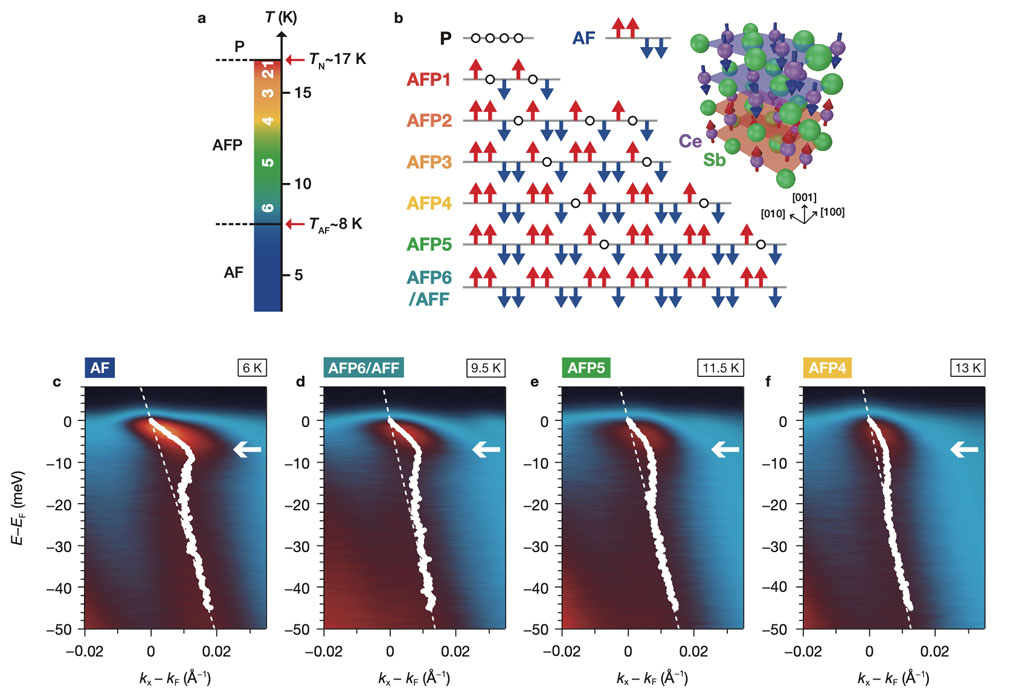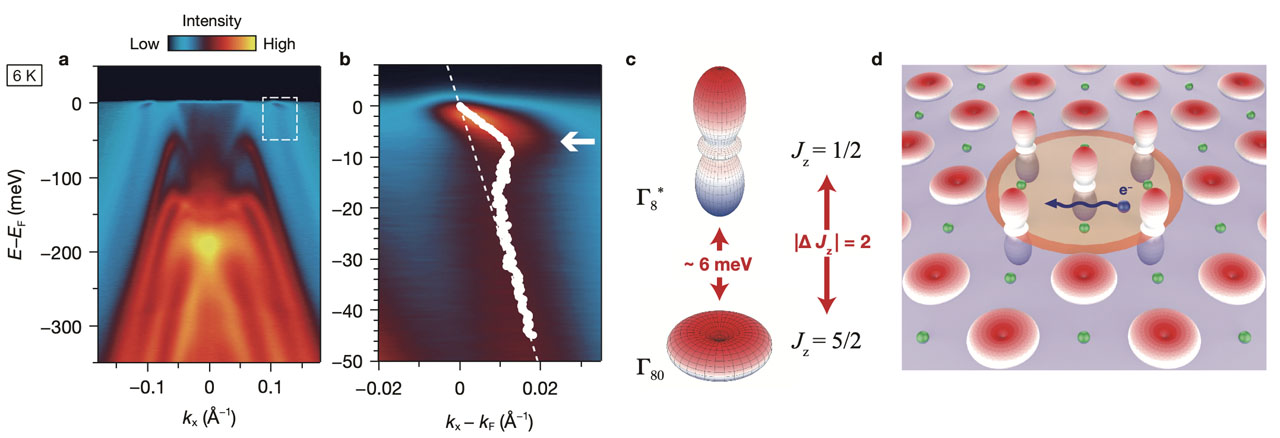Multipole Polaron in the Devil's Staircase of CeSb
Kondo Group
An electron-boson coupling, that leads to a quasiparticle (QP) of an electron combined with a local bosonic field, can cause interesting properties of condensed matter. For examples, dynamical behavior of a QP often plays roles in electronic instabilities leading to strongly correlated phenomena such as high-temperature superconductivity and colossal magnetoresistance. Thus, the investigation of such a QP is important in materials science. One of the most famous QPs is the polaron by electron-phonon coupling but such a QP state can be realized by coupling to other bosonic modes. However, only three types of electron–boson coupling have been experimentally identified: electron–phonon (or polaron), electron–magnon (or magnetic polaron) and electron–plasmon (or plasmaron) couplings, despite a number of investigations.
In this study, we found a new type of electron–boson coupling which leads to a unique QP state, ‘multipole polaron’, by investigating a rare-earth intermetallic compound CeSb [1].This new coupling mediates between the itinerant electrons and the bosonic field constituted by the crystal-electric-field (CEF) excitations of the localized 4f states. As evidence for it, we present laser angle-resolved photoemission spectroscopy (ARPES) [2] revealing band renormalization via the coupling of the mobile electron with the CEF excitation. This low-energy feature corresponds to a quadrupole CEF excitation (Jz = ±2) in the J multiplets of the 4f orbitals, possessing the ‘multipole’ freedom.
We present ARPES maps at the anti-ferromagnetic (AF) phase taken by high-resolution laser-ARPES in Fig. 1a, b. A clear signature for the band renormalization of the Sb 5p band is revealed: the Fermi velocity is largely reduced with a prominent kink at energy E−EF = −7 ± 1 meV, which directly manifests the presence of an electron–boson coupling (Fig. 1b). In fact, this low energy scale of the kink structure is consistent with the CEF excitation of the Ce 4f orbitals. The CEF splitting in the ordered 4f states of CeSb shows the ground state with Jz ≈ 5/2 (hereafter fΓ80) and the higher fΓ8 states with Jz ≈ 1/2 (hereafter f Γ*8) (Fig. 1c) [3]. The energy scale of the fΓ80 to f Γ*8 excitation is ~5–6 meV and shows good agreement with the kink energy (7 ± 1 meV). Since the quadrupole CEF excitation (|ΔJz| = 2) for fΓ80 to f Γ*8 has multipole character, our observations of the prominent kink reflect a coupling of the electron with the multipole CEF excitation. Such a QP with a large mass enhancement can be described as a multipole polaron that propagates in a sea of lamellar fΓ80 orbits but largely dressed with the self-induced quadrupole polarization of the longitudinal f Γ*8 orbits, as illustrated by Fig. 1d.

Fig. 2. (a) Temperature scale of the devil’s staircase transition at zero field. (b) Schematics of magnetostructures that comprise stackings of ferromagnetic (arrows) and paramagnetic (circles) planes along the crystallography axis [001]. The inset shows the magnetic texture for the magnetic ground state (AF phase). (c-f) Magnified images for the prominent kink in the band dispersion for several distinct phases.
References
- [1] Y. Arai et al., Nat. Mater. 21, 410 (2022).
- [2] K. Kuroda et al., Nat. Commun. 11, 2888 (2021).
- [3] J. Rossat-Mignod et al., J. Magn. Magn. Mater. 52, 111 (1985).
- [4] P. Bak, Phys. Today 39, 38 (1986).

